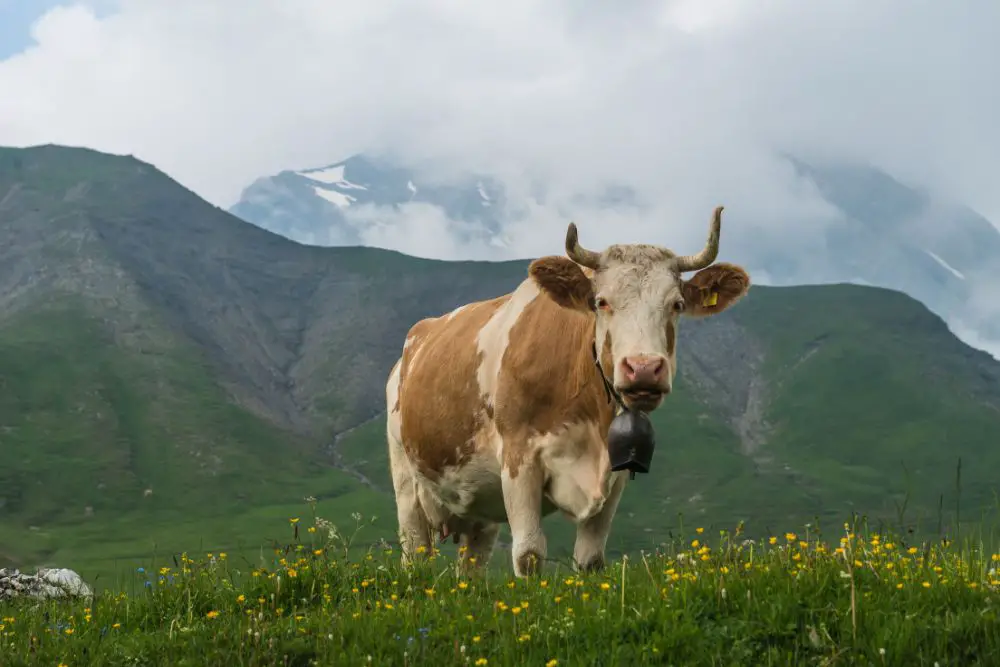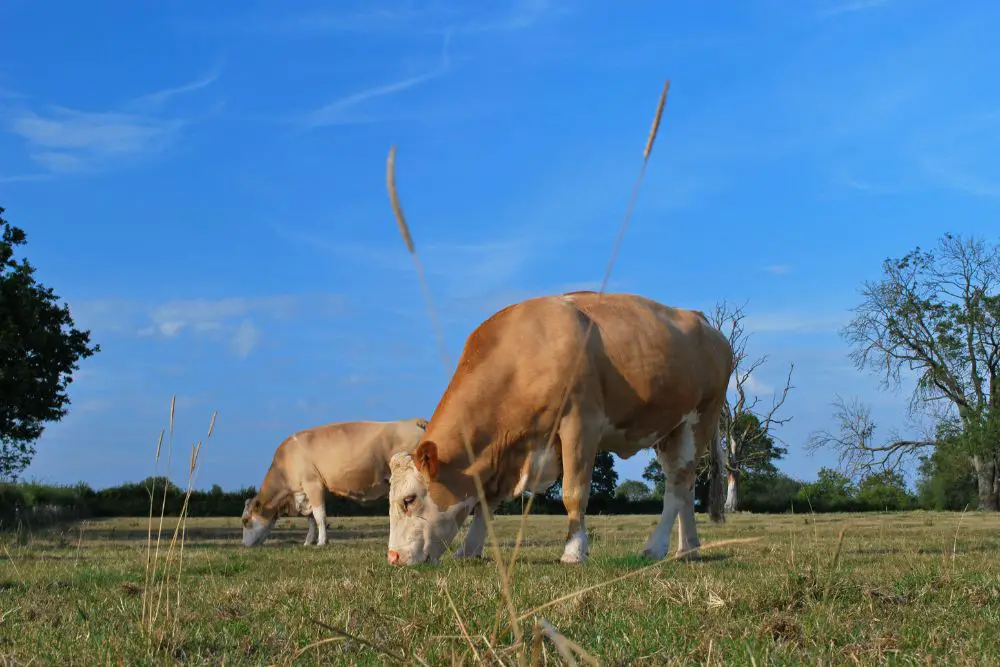The Simmental cattle are one of the world’s earliest and most populous cattle breeds, with a population estimated at 40-60 million head, coming closely behind the most numerous breed, the Zebu. They are a triple-purpose breed that is highly regarded worldwide but had a late start in the United States.
From their early days in the Middle Ages, Simmental cows and bulls have evolved into one of the most preferred beef cattle breeds for their naturally lean and tender meat.
Here’s what to know about the Simmental breed.
Table of Contents
Where Does The Simmental Cattle Breed Come From?
Simmental cattle originate from the Simme Valley in the Bernese Oberland region, on the western side of Switzerland.
The Simmental breed is believed to have developed as a cross between cattle indigenous to the Saane and Simme Valleys of the Canton of Bern in Switzerland and the large-bodied Medieval Cattle brought to Switzerland in the 5th century by the Allemmani.
Simmental bulls and cows were raised as a triple-purpose breed for meat, milk, and draught animals. Modern Simmentals are kept for crossbreeding and as dual-purpose cattle (milk and meat) or single-purpose bovines (beef production—especially in the US).
You may come across different names for the breed, depending on your location and the strain or trait of the cattle. In France, Simmentals are called Pie Rouge, Abondance, and Montbeliard.
In Germany, the Netherlands, Uruguay, Austria, and Spain, the Simmental breed is called Fleckvieh. Pezzata Rosa is used in Italy, while Simmentaler is used in Namibia and South Africa.
The breed also goes by the name Swiss Simmental or Simmental-Fleckvieh in its motherland and some other countries.
The name Simmental is used in the US, Brazil, Australia, Denmark, France (a recent shift from the Pie Rouge name), Bulgaria, Mexico, Canada, Poland, Ireland, Zambia, United Kingdom, New Zealand, and Zimbabwe.
The first Simmental herdbook was established in 1806 in Switzerland to recognize the “red and white spotted” bovines of the Simme Valley. In 1890, the Swiss Red and White Spotted Simmental Cattle Association was established.
Other national and international Simmental breed associations were formed as the Swiss breed spread from Switzerland to other parts of the world. The American Simmental Association (ASA) was formed in 1968, and the World Simmental Federation in 1974.
The WSF was established to unite Simmental breeders globally, enhance the exchange of information and research, and increase the importance and influence of the breed.
The number of Simmental cattle has increased globally through importations to other countries such as Paraguay, Sweden, Brazil in 1918, Australia in April 1972, Argentina in 1922, the Republic of China in 1976, and Britain, Ireland, and Norway in 1970.
The earliest importations include those shipped to Italy in the 1400s, North America in 1886, South Africa in 1895, and Guatemala in 1897.
There are conflicting accounts of the exact time when the Simmental first arrived in America. Reports indicate that members of the breed were present in 1887 in Illinois, 1895 in New Jersey, and between 1916 and 1920 in New Mexico and New York.
Despite their arrival in North America, the Simmentals didn’t hit the ground running right away. They had to be reintroduced in the region in the 1960s, with importations of semen in 1967 and the first purebred Simmental bull in 1971.
Simmental Cattle Breed Characteristics
Simmental cows and bulls have the following characteristics:
| Official Breed Name | Simmental |
| Origin | Switzerland |
| Appearance | Large, heavy animals with good muscling No specific coloration, but most have a gold to red color with white Some have a solid color, especially black or red in the US Heavy dewlap Upturned horns while some are polled Most have pigmentation around each eye Soft, short hair |
| Calf Weight | 85-90 pounds |
| Mature Cow Weight | 1,500-2,000 pounds |
| Mature Cow Height | 53-59 inches at the withers |
| Mature Bull Weight | 2,800 on average |
| Mature Bull Height | 59-62 inches at the withers |
| Ready To Breed | 2 years |
| Gestation Period | 9 months |
| First Calvings | 31 months Good mothering traits |
| Time to Slaughter | 2 years |
| Carcass Weight | 580-815 pounds for yearlings |
| Expected Lifespan | 10 to 12 years |
| Productive Lifespan | 5+ years |
| Known For | Docility, when regularly handled Triple-purpose breed (meat, milk and pulling power) |
| Weaknesses | Milk production is dependent upon the availability and quality of feed Some bulls can be highly aggressive |
| Climate | Adaptability to different rearing routines and environments because of their diverse bloodlines. Despite being from Europe, they are not great in extremely cold climates. |


What Is So Special About Simmental Cattle?
Simmental cattle are known for:
- High libido bulls with large scrotal size (the bulls have demonstrated the ability to manage high mating loads)
- More combined weaning gains and milk yield than other breeds of cattle
- High milk production levels (the Montbeliard are good milkers and are usually placed close to Holsteins in milk yields)
- Heavier and earlier finishing heifers and steers obtained as crosses between Simmentals and other breeds.
- Female crosses that reach puberty early and have long reproductive lifespans
- More muscle than most other beef breeds
- Higher yields of saleable meat because of little waste fat
- Excellent grazing abilities
- Rapid growth rates because of good feed conversion efficiency
- Calving ease because of low birth weights
Why Should I Raise Simmental Cattle On My Farm?
Simmental cattle are lovable animals to raise on your farm. Here’s why you might want to have them in your herd:
- Simmentals are very docile and have a relaxed bearing about them. Some even become petlike when they interact with humans from an early age because they crave attention.
- Simmentals have heavier and leaner carcasses with higher saleable beef yields, meaning more profitability potential.
- Bloodline diversity, which is usually manifested in the breed’s different colors. The members can be solid-colored (red or black) or gold to red with white. The head is usually white. There is a white band over the shoulder and similar marking on the legs, belly, and brisket.
- The pigment around the eyes of Simmental cattle makes them resistant to sunburn and pinkeye, hence lower vet bills.
- Simmental crosses exhibit likable characteristics such as high fertility rates, good marbling, high yield grades, and early maturity. Common crossbreeds include SimBrah when crossed with Brahman cattle and SimAngus when crossed with Angus cattle. You can also cross them with Limousin and Hereford cattle.
- Because of their high numbers, Simmental cows and bulls are easy to come by.
